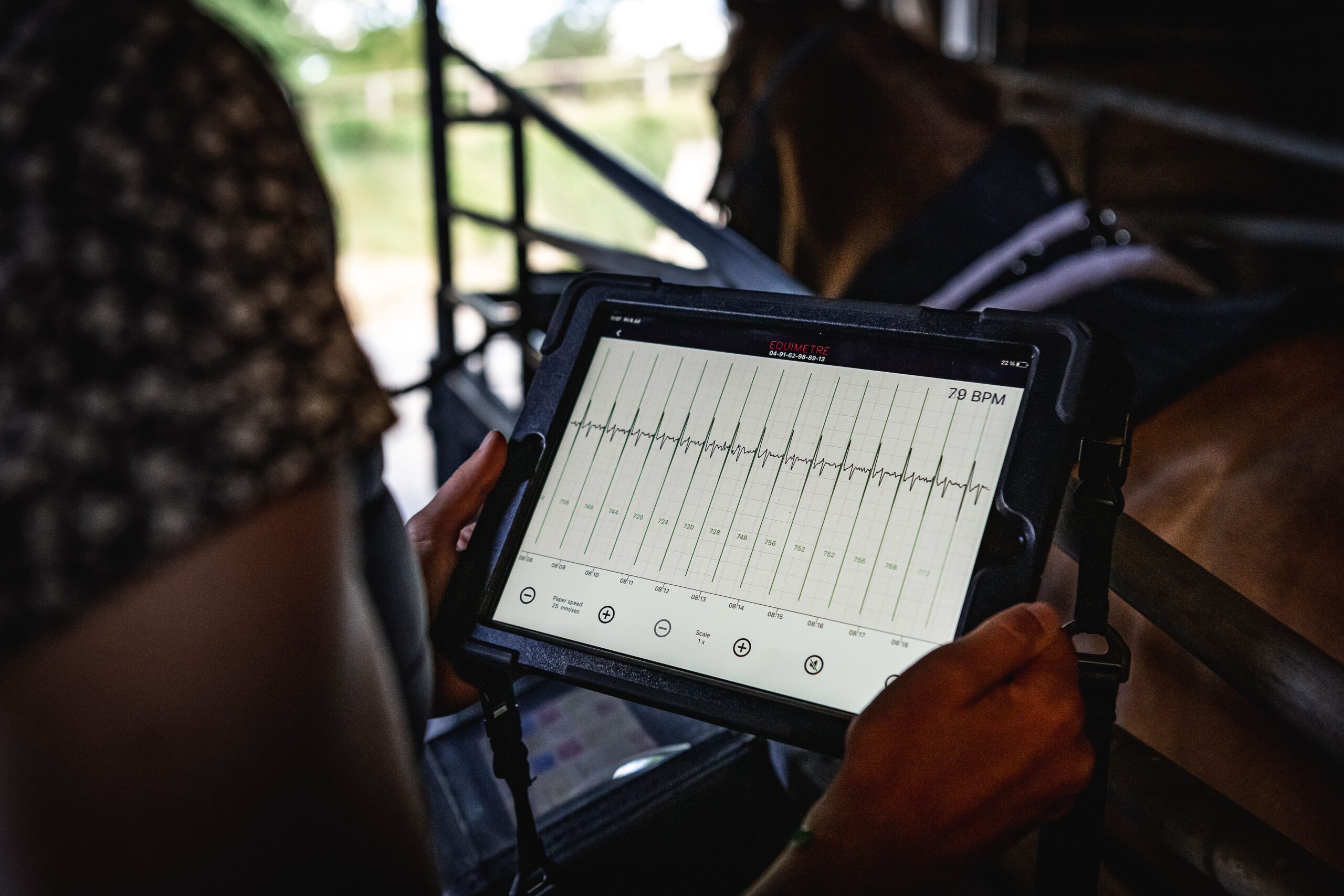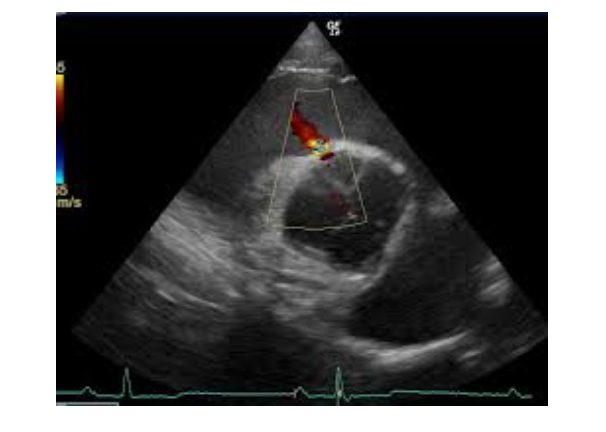The horse’s heart weighs 4 kg, is about the size of a basketball and is 25-30 cm long. The horse athlete produces intense efforts during training, and is able to considerably increase his cardiac capacity to adapt it to his practice, in order to send the necessary blood and oxygen to the muscles. The heart is the body’s blood crossroads, with arteries carrying oxygenated blood from the lungs to the organs and muscles, and veins carrying oxygen-depleted blood back to the body. This powerful muscle contracts during systole to propel the blood, and relaxes during diastole to refill with blood. The cardiovascular system can be compared to a huge orchestra, and the presence of any structural defect can alter the functioning of the system and throw the orchestra out of harmony. A heart murmur is added to the initially audible heartbeat and becomes a false note in the orchestra, requiring the trainer to intervene on several levels.
How does heart murmur manifest in the athletic horse? What is this due to? Does it have an influence on performance?
Properties of a heart murmur
Heart murmur
A heart murmur is an abnormal audible sound that overlaps or adds to normal heart sounds. Initially, we perceive two beats, called B1 and B2. In the case of a horse with a heart murmur, a third sound, called B3, is added. This abnormal sound is superimposed on one or both of the initial heart sounds, giving rise to a continuous murmur.
Three main types of breaths are defined:
- Physiological murmur is linked to an alteration of cardiac output, that is to say the volume of blood expelled per unit of time, due to a modified flow phenomenon.
- Functional murmur is common in racehorses, resulting from the intense blood flow required during sustained – exercise. Turbulent flows in the circulatory tract are due to the large diameter of blood vessels in the athletic horse.
- Pathological murmur results from a structural heart defect present from birth, leading to blood leakage.
The heart murmur constitutes a complexity for the veterinarian, who must accurately assess the capabilities of the horse presenting this murmur. It is essential to provide the owner-trainer with short and long-term indications of the state of cardiac health and to define a long-term monitoring strategy. The practitioner characterizes the abnormal noise based on several parameters such as:
- the point of maximum intensity,
- the stamp,
- the radiation,
- the localisation,
- the time of appearance,
- and the type of breath.
Possible causes
The emergence of a murmur, whether functional, physiological, or pathological, indicates a disturbance in the functioning of the cardiovascular system. It is essential to understand the origin of this variation in order to adjust the daily life of the athletic horse.
Pathological murmur, audible both at rest and during exercise, finds its origin in an illness or congenital malformation.
Physiological murmur is common in young horses and thoroughbreds. During exercise, it results from an intense contraction of the heart causing vibrations in the cardiovascular structures, without constituting a cardiac anomaly in itself. This type of murmur can be temporary and can also appear in a horse with an iron deficiency, suffering from colic, or suffering from cardiovascular disease.
How to detect a heart murmur?
Symptoms
In addition to the distinction in the perception of heart sounds with a stethoscope, manifestations of a heart murmur may result in unusual changes that should alert the owner or trainer.
During exercise, particularly in an athletic horse with developed sporting abilities, unusual signs may be observed in the presence of abnormal heart sounds. These signs include:
- Marked shortness of breath,
- Prolonged recovery,
- Heavy sweating indicating difficulty of the heart in propelling blood throughout the body to meet muscular and metabolic needs,
- Intolerance to physical exercise manifests itself as rapid fatigue or difficulty maintaining pace during exercise.
Underperformance, often linked to locomotor, respiratory, or cardiac problems (in order of frequency), requires a thorough medical evaluation by a veterinarian.
At rest, it is crucial to watch for certain signs indicating an abnormality, such as:
- A persistent cough associated with a possible heart murmur caused by the accumulation of fluid in the lungs,
- Weight loss even without intense exercise,
- Edema which may lead to abdominal or limb swelling,
- Pallor of the mucous membranes in case of anemia associated with heart murmur,
- General weakness leading to discomfort or difficulty moving.
These abnormal changes may indicate a decline in general physical condition.
Medical exams
In order to accurately identify the heart murmur profile, the veterinarian can perform various medical analyzes that will strengthen his or her assessment and provide a more detailed overview of the possible cardiac abnormality. As mentioned in the symptoms, these additional examinations can be triggered by poor performance or when purchasing a horse with an abnormal noise detected with a stethoscope.
To evaluate a heart murmur in a horse, the veterinarian may recommend several additional analyzes and examinations. These tests aim to determine the underlying cause of the heart murmur and assess the severity of the condition. Here are some of the analyzes that can be recommended:
- During the first medical consultation, the veterinarian examines the horse in various static and moving aspects, including cardiac auscultation with a stethoscope to locate and obtain a first impression of the location and intensity of the abnormal noise.
- An electrocardiogram (ECG) records the electrical activity of the heart, carried out both at rest and during exercise.
- A complete blood test and measurement of cardiac biomarkers can be carried out.
- Ultrasound provides detailed visualization of the heart structure.
- Chest radiography provides images of the anatomical structures of the thorax.
- Doppler, a medical imaging technique using ultrasound, analyzes blood flow conditions, displaying this information in color on a screen.
The sporting impact on horse athlete
The detection of a heart murmur in an athletic horse can have variable repercussions on his sporting capacity, depending on the size of the anomaly, the stage of development, and the nature of the condition. Some heart murmurs may be consistent with a high level of competition.
The cardiovascular system has the capacity to adapt to compensate for leaks, but conversely, it can decompensate if there is a possibility of long-term progression and persistence of blood circulation disorders. The emergence of exercise intolerance, an increase in heart and respiratory rate, irregularity of rhythm, as well as weakness, indicates that the athletic horse does not have all of its cardiac capabilities. It has been observed that physiological heart murmurs do not have any real demonstrated impacts on performance, likewise for horses with tricuspid regurgitations which compensate in terms of vascular capacity, thus allowing a lack of influence on performance.
Systolic murmur
Racehorses, particularly thoroughbreds, as well as young horses, have a significant prevalence of heart murmurs. In the United Kingdom, Timeform, a British publication specializing in horse racing, introduced an annual classification system based on several criteria, assessing the numerical value of the horse based on his performance. This qualitative index, expressed in pounds, is not negatively associated with heart murmurs, despite the high frequency of this anomaly linked to race and age.
If purchased, the diagnosis of heart murmur may pose an obstacle during the veterinary examination. The practitioner must precisely characterize the present breath to anticipate its possible development over time, thus allowing the future buyer to have all the necessary information. The impact of systolic heart murmur on the sporting performance of the athletic horse varies depending on its origin. However, it is possible that no clinical impact is observed in the horse, in which case it is referred to as a physiological ejection murmur.
Diastolic murmur
The development of a diastolic heart murmur occurs gradually, usually after age 10, and is less common than the systolic murmur. The vital and sporting prognosis depends on the speed of evolution of the breath, although this has no impact on the sporting performance of racehorses. The slow onset allows good tolerance in horses, provided that no signs of heart or lung failure appear.
According to a study published in the Journal of the American Veterinary Medical Association in 2000, no analysis of running performance has revealed a link between athletic performance and this type of breath. Additionally, the dynamic examinations performed in this study indicate that horses without audible murmurs at low heart rates will not develop murmurs once the heart rate is increased.

Conclusion
To date, there is no treatment for heart murmurs. Nevertheless, regular veterinary monitoring is recommended, particularly in the case of athletic horses subjected to intense repetitive effort, which places greater demands on their cardiac capacity.
Using EQUIMETRE to monitor a horse’s physical condition on a daily basis is a valuable tool for both trainer and owner. It provides a global view of a horse’s various performances, which can be used as a reference. The sensors record heart rate and transmit an ECG in real time to the data analysis platform, which can be closely monitored with the help of our data analysts at Arioneo. The heart rate is an indicator of the horse’s good health during exercise and during recovery, calculated 15 minutes later. The trainer can then easily see the positive or negative progression of the horse by comparing previous performances and training in terms of stride, locomotion and more. An abnormality may therefore manifest itself as a change in relation to reference values, and will require in-depth auscultation to find its cause.
To find out more about the use of EQUIMETRE in the case of souffles, we recommend that you take a look at this Webinar : this webinar
The sensor created by Arioneo enhances training monitoring by providing precision and regularity. EQUIMETRE allows you to act at the slightest sign of doubt, and to prevent possible pathologies or ailments. EQUIMETRE is constantly evolving to provide even greater precision, with data transmitted in real time. The platform communicates valuable data to the trainer, reflecting the horse’s response to exercise in terms of workload, locomotion and heart rate.
Keywords : heart murmur, performance, horse, cardiovascular, ECG, heart rate, rest, effort
Sources :
-
Christman, U. (2016, March). Dossier: cardiac affectations and their diagnoses in equines. Le Nouveau Practicien Vétérinaire, 11, 12.
-
What is a heart murmur? – Clinique vétérinaire de Grosbois (n.d.). Clinique de Grosbois. Retrieved January 17, 2024
-
What are the consequences of a heart murmur in horse athletes – Arioneo Webinar (2022, July 6). YouTube
-
LATOUCHE, N. (1980, April 9). LA FIBRILLATION ATRIALE CHEZ LE CHEVAL [RETROSPECTIVE STUDY AND CLINICAL OBSERVATIONS]. In Thesis.
-
CADON, A. (2011, December 19). PRACTICAL REALIZATION OF THE ECHOCARDIOGRAPHIC EXAMINATION IN THE HORSE AND PONY BASED ON BIBLIOGRAPHIC AND EXPERIMENTAL DATA. [Thèse].
-
Heart murmurs in the horse: how to identifier them? What to do? – SNGTV. (n.d.). SNGTV.
-
MASSENAVETTE, M. (2011, June 30). LEARNING THE DIAGNOSTIC APPROACH IN EQUINE CARDIOLOGY CONSULTATION FROM ILLUSTRATED CASES USING A COMPUTER TOOL [Thesis]
-
Young, L. E., Rogers, K., & Wood, J. L. N. (2008). Heart murmurs and valvular regurgitation in thoroughbred racehorses: epidemiology and associations with athletic performance. Journal of veterinary internal medicine, 22(2), 418-426.
-
Kriz, N. G., Hodgson, D. R., & Rose, R. J. (2000). Prevalence and clinical importance of heart murmurs in racehorses. Journal of the American Veterinary Medical Association, 216(9), 1441-1445.
-
Reef, V. B., Bonagura, J., Buhl, R., McGurrin, M. K. J., Schwarzwald, C. C., van Loon, G., & Young, L. E. (2014). Recommendations for management of equine athletes with cardiovascular abnormalities. Journal of veterinary internal medicine, 28(3), 749-761.
-
Vanel, M. (2010). The pathological dominants of the eventing horse (Doctoral dissertation).
-
Variable, O. R. D. E. R. S. (2011). Heart Murmur. Clinical Veterinary Advisor: The Horse, 242.
-
COTTIN, C. (2011). Prevalence of anorganic heart murmurs in a population of clinically healthy dogs.
-
Evaluation of cardiovascular function in adult horses during systemic inflammatory response syndrome. (n.d.). DUMAS.
-
Ultrasound in equine athletes. (n.d.). Cardio&Sport, 24.
-
Equine medical imaging | Equine veterinarians Greater West. (n.d.). Equiwell.
-
FERRAN, A. (2023). Physiology of heart sounds and ECG.
-
Toutain, P.-L., LEFEBVRE, H., & DOSSIN, O. (1993). Physiological heart sounds in dogs and horses.
-
Kriz, N. G., Hodgson, D. R., & Rose, R. J. (2000). Prevalence and clinical importance of heart murmurs in racehorses. Journal of the American Veterinary Medical Association, 216(9), 1441-1445.



